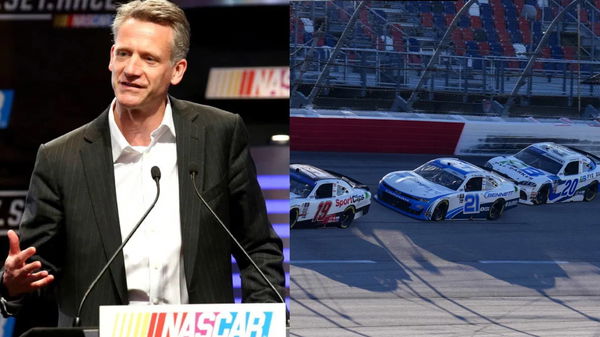
via Imago
Steven Phelps and Xfinity Race (Source: Getty/Imago)

via Imago
Steven Phelps and Xfinity Race (Source: Getty/Imago)
“Saturdays are superior. Sorry, not sorry.” Last November, former NASCAR spotter Brett Griffin triggered a huge debate when he unapologetically called Xfinity races more entertaining than Cup races. He even compared it to the difference between college football and the NFL. Griffin was not alone. A few months back, Denny Hamlin had also echoed similar thoughts on his podcast, calling Xfinity to produce more passes.
However, despite the thrilling product, the money in the Xfinity Series remains a fraction of what the Cup Series gets. The prize money gap between Xfinity and Cup is enormous, and the recent Darlington purse proves this issue once again. The Cup Series purse stands at $11,055,250, while the Xfinity Series only gets $1,651,939. This raises an important question: Why is NASCAR not supporting its second-tier series as it should?
ADVERTISEMENT
Article continues below this ad
A financial divide too large to ignore
NASCAR’s financial structure strongly favors the Cup Series. This is not new, but the gap has widened in recent years. This disparity is even more baffling when looking at the latest Xfinity viewership numbers. The series has experienced a massive surge in popularity. Saturday’s Martinsville race drew 1.014 million viewers, a 19% increase from last year. Across the first seven races, Xfinity’s average viewership has jumped by 28% compared to 2024.
Fans are tuning in, but NASCAR refuses to reward the series financially. The Cup Series attracts the biggest sponsors, and its charter system guarantees financial security for teams. Even back markers in the Cup are assured a decent payout, while Xfinity teams scrape by with minimal funding. The financial imbalance between the series hurts young drivers. And to keep things on record, this is not the first race when NASCAR’s payout has seen such a huge parity.
This year’s Ambetter Health 400 in Atlanta had a purse of over $11 million, nearly $2 million more than last year. Meanwhile, the Xfinity Series received only a slight bump in prize money to raise it to around 1.6 million. In fact, the Las Vegas Xfinity purse decreased by $149,339 compared to last year. Just to put it in perspective, the Cup race winner gets almost 8 to 10 percent of the total payout. So, the winner of this year’s Cup race at Atlanta, Christopher Bell, received around 1 million dollars of prize money which is more than what half of the Xfinity field would have received.
Darlington purses this weekend includes all payouts, all positions, contingency awards, year-end points fund, etc.; for Cup, includes all payouts for charter teams for participating and historical performance:
Cup: $11,055,250
Xfinity: $1,651,939
— Bob Pockrass (@bobpockrass) April 2, 2025
This imbalance forces the Xfinity teams to rely on sponsorships rather than race winnings. Many talented drivers struggle to move up the ranks because financial backing, not performance, often determines who gets a seat. In 2024, three-time Cup Series champion Joey Logano revealed that while he gets paid to drive in the Cup Series, he has to pay out of pocket to race in the Xfinity or Truck Series.
“I’d like to race more than what I do. I’m telling you, our sport, it’s crazy. It’s crazy that, and I’ll be real with you here, I get paid to drive a [Cup Series] car. That’s great. I have to pay to drive an Xfinity car or a Truck. I have to show up with money on the doorstep to drive one… Unfortunately, that’s where our sport is, and that’s why it’s so hard for kids to make it these days. If a two-time NASCAR champion can’t drive an Xfinity car for free…how do you expect a kid that’s got no experience to come up?” the Team Penske driver had said.
On the flip side, NASCAR analyst for Prime Video Corey Lajoie spoke about how the lower-tier series does not garner as many viewers as the Cup Series, and that does not incentivize him to drive there. “It’s all about Sunday. I don’t wanna go run F3, I wanna be a Formula 1 driver…Sure, do you wanna go pump the ego up and hold a trophy on a Friday when there’s 12 people in the grandstands?” Lajoie told FOX Sports’ Bob Pockrass ahead of the 2025 season. Lajoie is currently without a full-time ride in the Cup Series and even rejected a Truck Series ride because of a last-minute crew chief change.
Logano and Lajoie’s comments speak volumes about NASCAR’s priorities. The Truck Series faces an even tougher battle. Some fans have labeled it a “poverty league” due to its embarrassingly low payouts. The costs of running a competitive team do not drastically change between the series, yet the prize money does. Travel, equipment, and crew salaries remain expensive, but the financial rewards in Xfinity and Trucks simply don’t match the investment. But what’s the solution?
Trending
ADVERTISEMENT
Article continues below this ad
How can NASCAR improve the financial stability of its lower national series?
With the growing concerns and frustration among fans, NASCAR needs to close the gap between the Cup and Xfinity. The first step is increasing the prize money for the lower-tier series. If viewership is rising, the financial rewards should match that growth. The latest NASCAR media rights deal has brought in more money, but that money needs to be distributed more fairly.
While Cup Teams get around 49% of that money through charters, NASCAR also needs to channel it to lower series. A radical but practical solution would be to implement Charter system for Xfinity and Truck teams too. However, it will be very difficult in current scenario as multiple cup teams are currently indulged in legal battels around various charter deals. Another option is offering bonus incentives for top-performing Xfinity and Truck teams to help them stay competitive.
While the Xfinity series runs Dash 4 Cash races, it needs a radical increase in payout amount for it. Also, only four or five drivers make their way to that fight after early season races, which makes it difficult for under-funded teams to fight for it. Another solution to this financial debacle can be increasing the sponsorship flow. While Cup drivers get a lot of media exposure, Xfinity and Truck guys fail to match it. It reflects the sponsorship influx as well.
ADVERTISEMENT
Article continues below this ad
So, increasing their media presence will also help them. Ultimately, NASCAR needs to recognize that the sport’s future depends on the success of all its series. If young drivers can’t afford to race in Xfinity, the talent pipeline will dry up. If teams can’t sustain themselves financially, the field will shrink. NASCAR cannot afford to let that happen.
ADVERTISEMENT
ADVERTISEMENT
ADVERTISEMENT
ADVERTISEMENT






